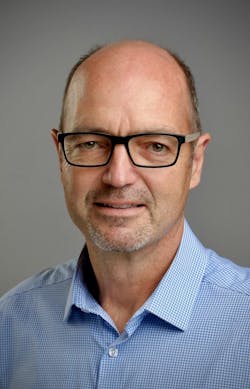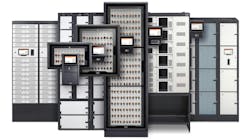Data Center Intelligence: Carsten Baumann, Schneider Electric
The Data Center Frontier Executive Roundtable features insights from industry executives with lengthy experience in the data center industry.
Here’s a look at the Q2 2025 insights from Carsten Baumann, Director of Strategic Initiatives and Solution Architect with Schneider Electric.
In his role as a Solution Architect with Schneider Electric, Carsten Baumann is helping clients with their Industrial IoT and Sustainability initiatives in the Commercial & Industrial and Data Center markets that allow to achieve greater resiliency, achieve sustainability objectives and create economic benefits. In prior work, he supported the Consulting and Engineering community by advising on resource-optimized energy management solutions in the data center market. He offers over three decades of experience in the data center, broadcast, telecommunications, AV and IT industry. His papers have been published in peer-reviewed journals and he frequently speaks on national and international venues. Baumann joined Schneider Electric in early 2012. He is an active member of iMasons and the Green G working group (Next G). Until 2018, he served as Treasurer and President on the board of AFCOM Southern California, was chairman for The Global Society for Asset Management (G-SAM). He recently completed a program at MIT in Smart Manufacturing and holds an electrical engineering degree from the Theodor-Litt-Schule in Giessen, Germany.
AI Is Reshaping Infrastructure: How Are You Responding?
Data Center Frontier: How is your organization adapting to the infrastructure demands of AI? As artificial intelligence continues to redefine the design priorities for power, cooling, and site architecture, what specific innovations or strategic adaptations has your company implemented over the past year to meet the performance and deployment requirements of next-generation AI workloads?
Carsten Baumann, Schneider Electric: The current boom in AI is creating significant opportunities for the entire data center ecosystem. Demand growth projections indicate an increase of well above 100GW in the U.S. by 2030, which implies more than doubling existing infrastructure. Economically viable solutions to challenges such as power generation, load flexibility, transmission and distribution systems, and efficiencies in the design, deployment, and operations of data center assets are necessary.
Better demand planning is required to align the supply chain and manufacturing capacities responsibly. Coordination among stakeholders to create system synergies rather than isolated improvements is essential. Innovation and a shift in thinking and operations are needed. AI can be utilized to optimize the planning, designs, and operations of new data center capacities. At Schneider Electric, efforts include using AI tools to model energy demand, generation, reliability, and availability. Manufacturing capacity is being increased, and hardware components are being made more intelligent with embedded sensors and software.
At Schneider Electric, we have also implemented AI in our Smart Manufacturing processes to enhance productivity, quality and the optimization of energy use. From a product perspective, digital smart products enable system optimization and flexibility beyond static peak load designs. Overprovisioning is becoming obsolete, and smart energy management and automation will ensure reliable energy access to support the world’s digital transformation.
We are at the forefront of the digital revolution. Our customers face unprecedented challenges. Building the necessary infrastructure in creative and new ways forces us to accelerate innovation. For example, as an industry member of the EPRI FLEX program we are driving innovation and industry collaboration to collectively solve these massive power and cooling demands. According to the North American Electric Reliability Corporation (NERC), winter peak load is projected to rise from 694 GW in 2024 to 843 GW by 2034—a 21.5% increase that marks one of the most significant surges in modern grid history.
The Federal Energy Regulatory Commission (FERC) offers an even more aggressive outlook, forecasting 128 GW of peak load growth by 2029, driven largely by the rapid expansion of commercial and industrial electricity demand. Consequently, we educate policymakers to enable an environment that supports innovation, accelerate on-site power generation that supports energy dominance, reduce red tape to improve interconnection ques, and to create new incentives to embrace data center load flexibility. With the acquisition of Motivair, we can address our customers’ advanced liquid cooling and thermal management requirements.
Speed to Market Is a Competitive Edge: What’s Your Playbook?
Data Center Frontier: What strategies are helping you deliver infrastructure at speed without sacrificing resiliency? With timelines for data center delivery compressing across both hyperscale and edge environments, what proven approaches—whether in engineering, supply chain management, or partner collaboration—are enabling your organization to accelerate deployment while maintaining reliability, efficiency, and sustainability?
Carsten Baumann, Schneider Electric: Increasing manufacturing capacities is a clear strategy, but it carries long-term risk. To mitigate this, we are securing supply chain agreements with customers to ensure infrastructure capacity is available when needed, reducing risk for both parties.
An important factor for meeting compressed timelines is to design and build modularly. Prefabricated electrical, mechanical, and IT packages are accelerating the deployment of capacity, both for hyperscalers and at the edge. There are several advantages as various published use cases demonstrate.
Standardization vs. Customization: What’s the Right Balance Now?
Data Center Frontier: How are you balancing standardization with client-specific customization in 2025? Given the dual pressures of rapid scaling and the unique demands of AI and hybrid workloads, how is your team navigating the trade-offs between delivering standardized infrastructure and meeting bespoke customer needs? Where do you see flexibility delivering the most value today?
Carsten Baumann, Schneider Electric: Customization is important. For example, switch gear can be configured with different breakers and bus architectures to match project needs. This is known as Configure to Order (CTO). Our manufacturing processes support this approach. Engineering to Order (ETO) is more complex, requires more time, and typically demands a premium investment.
UPS technology also benefits from modular architecture that provide initial capacity and can scale for future demand, provided infrastructure supports it. Reference designs help customers evaluate needs quickly and accurately, though they may not be built exactly to those specs. Standardizing electrical system designs could benefit the industry, but geographical and code requirements necessitate customization. Cooling systems also need customization based on location. Vendors aim to balance flexibility with availability and capacity impacts.
The short answer is, we offer both. Standardized and bespoke. Typically, we observe that the larger a single system becomes, the more unique it seems to become. As mentioned earlier, supply chain agreements and the typically associated perhaps bespoke systems, mitigates against the complexity and cost associated with it. Yes, it’s unique, though we need 500 of them. It may be unique to the industry, not to that customer though. Prefabrication is a fantastic example that allows to build infrastructure more rapidly, at better quality and at an accelerated time schedule.
What Does True Data Center Industry Innovation Look Like in 2025?
Data Center Frontier: What does meaningful innovation in the data center sector look like right now? In a marketplace crowded with bold claims and emerging technologies, how do you separate marketing noise from truly transformative innovation? And what is one underappreciated technical or strategic breakthrough your organization believes will materially influence data center development over the next 12 to 18 months?
Carsten Baumann, Schneider Electric: Data and software that allows data to become actionable play a crucial role. It facilitates operational insights and flexibility. Additionally, it accelerates the design process, enhances operational efficiency, minimizes unplanned downtime, and reduces the tendency to overprovision system designs, all of which can contribute to cost savings.
Onsite power generation will become standard. Some in our industry believe data centers will always be grid-connected, but others have different views. Even with grid connection, developers may still need onsite generation for sufficient power. Supporting local communities and maximizing operational efficiency while promoting sustainability are becoming essential. These new efficient energy operations require automation and management, making software crucial.
About the Author
Matt Vincent
A B2B technology journalist and editor with more than two decades of experience, Matt Vincent is Editor in Chief of Data Center Frontier.



